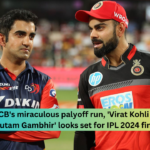According to Prime Minister Narendra Modi, the lowest-income individuals, young people, farmers, and women are the cornerstones of a developed India.During his speech on Saturday, Prime Minister Narendra Modi stated that the most significant beneficiaries of his government’s pro-poor policies were the Dalits, other backward classes, and tribal people. He also stated that the government’s greatest success in the past 10 years was to pull 25 crore people out of poverty.
The Prime Minister was addressing the ‘Viksit Bharat Viksit Gujarat’ program through the use of video conferencing. During this program, he inaugurated and laid the foundation for more than 1.3 lakh homes in the state that were constructed through the Pradhan Mantri Awas Yojana (PMAY) and other housing projects.This statement was made by Modi in response to claims made by the opposition that his government is disregarding SCs, STs, and OBCs. “The biggest beneficiaries of our government’s pro-poor schemes are Dalits, OBCs (other backward castes), and tribals,” Modi added.
According to Modi, the poor, young people, farmers, and women are the pillars upon which a developed India is built.In the course of the program, he also engaged in conversation with the people who had benefited from the housing schemes, and he stated that this event signified the successful completion of the “Modi ki guarantee.”

Over one hundred and eighty locations across all of Gujarat’s districts were used to host the program, with the primary event taking place at Deesa, which is located in the Banaskantha district.When compared to the time period prior to 2014, Prime Minister Modi stated that the development of dwellings at a rapid rate is taking place for those who are economically disadvantaged. He stated that there was a bad allocation of funds for the construction of dwellings for the poor, and that there were leakages in the form of commissions and other forms of money during earlier periods. According to him, the amount of money that is being sent for homeless people’s homes has now surpassed ₹2.25 lakhs. This money is being deposited straight into their bank accounts, hence eliminating the need for intermediaries.
In addition, he stated that there is now the liberty to construct residences in accordance with the requirements of the families, in addition to constructing toilets, connections to the water supply, connections to the gas supply, and connections to the electricity supply. “The poor have been able to save money thanks to these facilities,” he remarked. In addition, Prime Minister Modi emphasized that women are now able to own their own homes because the residences are now registered in their names.
It was mentioned by the Prime Minister that Gujarat has achieved significant progress in the PM Awas Yojana program, and he also mentioned that more than 9 lakh residences have been built in the urban regions of the state. More than 5 lakh homes have been built in rural regions as a result of the Prime Minister’s Awas – Gramin program. He stated that new technology is being implemented in order to guarantee both quality and speed in the construction process. According to him, the Lighthouse initiative has resulted in the construction of one thousand ones homes.

In addition to expressing confidence, the Prime Minister invited those who would benefit from this initiative to come forward and show their support for it so that they may help eradicate poverty.
During his address to the gathering, the Prime Minister expressed his joy at the fact that people from all over the state are contributing to the progress of Gujarat’s development. He recalled his attendance at the Vibrant Gujarat Global Summit in January, which is now twenty years old, and he praised the efforts of the state government for its involvement in the event.Specifically, he emphasized that a house that is held by the poor ensures that they would have a better future. In light of the fact that families are growing, the Prime Minister emphasized the ongoing efforts of the government to construct new homes for every individual who is economically disadvantaged.
The number of houses is 1.3 lakh, as you can see. Even though I was present at a national-level program with the purpose of providing residences as part of the PMAY, I did not witness such a significant number. My congratulations go out to the administration of Gujarat. Owning a home is a surefire way to ensure a brighter future for any individual who is struggling financially… When a project of this magnitude is finished, the nation refers to it as the “Modi ki Guarantee,” which literally translates to “guarantee of fulfillment of the guarantee.

” He stated this in his acceptance speech.The Prime Minister emphasized programs such as Per Drop More Crop and drip irrigation, which have been beneficial to agriculture in the areas of Banaskantha, Mehsana, Ambaji, and Patan. He used these programs to recall the water scarcity that had occurred in the region in the past. He stated that the number of pilgrims will be significantly increased as a result of the development initiatives in Ambaji. It was stated by him that the broad-gauge line that had been waiting since the time of the British will soon be finished and will contribute to the creation of a significant number of jobs. The line will run from Ahmedabad to Abu Road in Rajasthan.
When asked about his hometown of Vadnagar, the Prime Minister responded by stating that the recently discovered ancient relics, which date back around three thousand years, have been attracting a significant number of tourists. It was stated by him that locations such as Hatkeshwar, Ambaji, Patan, and Tarangaji will assist in the transformation of North Gujarat into a tourist destination comparable to the Statue of Unity.
There were crores of individuals from Gujarat who became linked with the Viksit Bharat Sankalp Yatra, according to the Prime Minister, who praised the successful organization of the Yatra over the months of November, December, and January.














